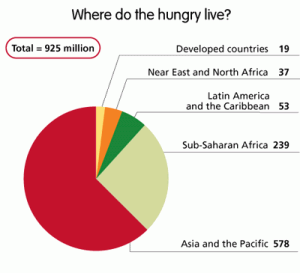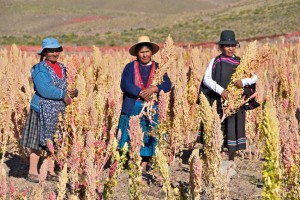Population, Global Food Security & Empowering People
Aug 23rd, 2013 | By admin | Category: Food and Hunger/AgricultureBy Suzanne York, www.howmany.org
Can the world improve food security in the face of rising food prices, population growth, climate change, poverty, and gender inequality?
New research in the journal Climatic Change found that a changing climate will likely push food prices up 20 to 40%, regardless of cuts to future carbon emissions. As reported on the blog Climate Progress, “staple crops like rice, wheat, and grains — which make up the vast majority of global diets, especially for the poor — could see the biggest hits, with big costs for global economic welfare.”
And despite the promises, industrial agriculture will not meet the food needs of a growing global population.
The United Nations estimates that the world will need to produce 70% more food by 2050 to meet the demands of the growing population. One key solution to addressing the increasing effects of climate change and population growth is to invest in women.An infographic by the U.S. Agency for International Development (USAID) on the Global State of Agriculture highlights how in the face of expanding population food production will have to rise to meet food security needs. A few key statistics on agriculture include:
- Agriculture is responsible for 86% of rural population’s livelihoods;
- Women make up 43% of the agricultural workforce (and 50% in parts of Asia);
- Women farmers are less productive than men because of less access to land, water, seeds, training, and credit.
In fact, with increased empowerment, women could be more productive, which would benefit communities around the world. With greater equality, such as access to resources, women could increase crop yields by 20-30%. In turn, this could result in up to a 4% increase in crops that would feed more than 150 people.
To better address food and hunger issues worldwide, Representatives Betty McCollum (D-MN), Aaron Schock (R-IL), and Jim McGovern (D-MA) introduced the Global Food Security Act (H.R. 2822) this past July. Amongst other things, the bill recognizes food security and nutrition as essential contributors to global development, health, peace and stability.
Sixty percent of the 925 million people on this planet who don’t get enough to eat are women. However, up to 150 million more people would have enough to eat if women had equal access to agricultural production. (See the World Food Programme’s Global Hunger Map 2012 here).
Most importantly, this bill will help ensure smallholder farmers – especially women – have the tools, education, and training they need to produce food for their families, communities, and countries.
Women Thrive Worldwide, an international organization working to end poverty by advocating for greater investment in women, focuses on some key aspects of the Global Food Security Act that will impact women. The organization emphasizes that the bill would:- Promote food access, availability, and stability. In situations of conflict, natural disaster or just extreme poverty, women often eat last and eat least. They need food stability, ensuring that food reserves and markets are open to them during vulnerable times.
- Increase the yield and capacity of smallholder farmers, the majority of whom are women. This means supporting women in getting the seeds and fertilizer, trainings, credit, and the overall market access they need to increase production and sell at local markets.
Take action and contact your congressional representative to support and pass the Global Food Security Act. It will empower more women and rural farmers and ease food insecurity in places confronting many serious economic and environmental challenges.
Suzanne York is a senior writer with the Institute for Population Studies.


